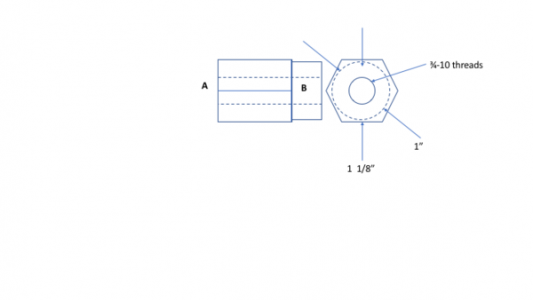Full disclosure: I'm an utter amateur machinist, and have basically no idea what I'm talking about when I use (most) machining terms. Please bear with me.
I need to make an assembly that looks like a tall nut (a "connector nut" might be the proper name) in silicon bronze (for underwater use on a boat). The last roughly 3/4" of one end of the tall nut would be turned down to be cylindrical; the other end would actually be doing work as a nut. Here's a crude attempt at a mechanical drawing to show what I mean:

The part labelled "A" is hex; the part labelled B has been turned down to be a 1" diameter cylinder (with threads in the middle, but those don't matter at the "B" end).
I could start with rod, bore it out, cut internal threads, mill flats on the "nut" end, etc., but frankly...I'd probably screw it up three or four times, at great expense (both in materials and frustration).
So now I'm thinking that I could just stack up three nuts (perhaps threading them snugly onto a rod as a starting point) and braze them together. I'd have the threads I need right from the get-go, and the remainder of the assembly doesn't need to be terribly strong...but it does need to be electrically connected to the front part, or I'd be considering using something like epoxy to assemble things.
Is it possible to do this? Would I find that the brazing material wicked into the space between adjacent nuts, ran all the way to the center threaded rod, and thereby messed up everything by turning the whole assembly into a kind of weak rod? Is there some obvious way to do this that I'm missing?
Is there some obvious way to do this that I'm missing?
[For those who care about details: I need to put a donut-zinc onto the back end of my propeller shaft; the geometry of the propeller cutout, the rudder, and the deadwood make putting it in the front not really feasible. The "nut" end of this thing is the second nut for the propeller; the cylindrical tail is there to give the zinc something to grab onto. The current version involves copper tubing brazed to a nut, but the OD is 7/8, and I need a larger zinc, which means going to a 1" center.]
I need to make an assembly that looks like a tall nut (a "connector nut" might be the proper name) in silicon bronze (for underwater use on a boat). The last roughly 3/4" of one end of the tall nut would be turned down to be cylindrical; the other end would actually be doing work as a nut. Here's a crude attempt at a mechanical drawing to show what I mean:

The part labelled "A" is hex; the part labelled B has been turned down to be a 1" diameter cylinder (with threads in the middle, but those don't matter at the "B" end).
I could start with rod, bore it out, cut internal threads, mill flats on the "nut" end, etc., but frankly...I'd probably screw it up three or four times, at great expense (both in materials and frustration).
So now I'm thinking that I could just stack up three nuts (perhaps threading them snugly onto a rod as a starting point) and braze them together. I'd have the threads I need right from the get-go, and the remainder of the assembly doesn't need to be terribly strong...but it does need to be electrically connected to the front part, or I'd be considering using something like epoxy to assemble things.
Is it possible to do this? Would I find that the brazing material wicked into the space between adjacent nuts, ran all the way to the center threaded rod, and thereby messed up everything by turning the whole assembly into a kind of weak rod?
[For those who care about details: I need to put a donut-zinc onto the back end of my propeller shaft; the geometry of the propeller cutout, the rudder, and the deadwood make putting it in the front not really feasible. The "nut" end of this thing is the second nut for the propeller; the cylindrical tail is there to give the zinc something to grab onto. The current version involves copper tubing brazed to a nut, but the OD is 7/8, and I need a larger zinc, which means going to a 1" center.]

